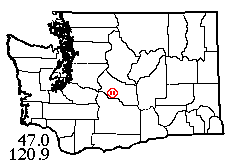
The object of this page is simply to show what fun it is to be a "bug" collector! As editor of Scarabogram, newsletter of "Scarabs: The Bug Society," I sometimes report on field trips; mostly my own trips collecting spiders for the research collection at the Burke Museum. The following notes almost all appeared in Scarabogram in their original forms. References to the editor mean me; most other persons mentioned are Scarabs members. Many other trips occurred but were not reported in enough detail to be worth including here. The date of the field trip heads each paragraph. Maps showing the location of sites within Washington state follow the grid system outlined in the Washington Spider Checklist. RETURN TO INDEX
 |
6 VII 1986: A recent field trip to the Quartz Mountain area, Kittitas County, with Scarabs Kirk, Pelham and Crawford was most successful. Bob Kirk got the first Kittitas County record of the white butterfly Pieris napi; at Gnat Flat, Jon Pelham got a hybrid specimen of the two coppers Lycaena mariposa + L. nivalis; among other good butterflies. Yr editor came away with a fine set of spiders and a lovely metallic blue cerambycid beetle. The 26 spider species included 3 uncommon gnaphosid ground spiders. Spider habitats included mountain meadows with sagebrush (at 4720 feet!) and a high aspen grove.
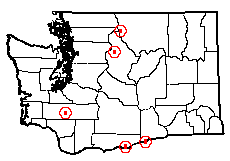 |
VI-VII 1988: Since typing the last newsletter, I've been on 4 collecting trips, all with fellow Scarabs. On June 18-19, Helen Moser and her charming daughter Kerstin were nice enough to take me on a very useful trip to the lower Columbia River (east of the Gorge). Our campsite on Whitcomb Island was not too well chosen. A freight train parked on a nearby siding and spent several hours clanking in the night; in the morning we found several earwigs in our sleeping bags with us! Both Mosers were good sports and helped enthusiastically with the collecting; we got good spider samples from three sites and had further adventures with lizards and baby ducks. On June 25, I had a useful though short visit to Ike Kinswa State Park (near Mossyrock), courtesy of the Zahlers and the annual beekeepers' picnic. On July 3 and 16, I went on one-day spider/butterfly trips with Pat Foster (the second time with her son Mike along), visiting the Trinity and Washington Pass areas, north Cascades. Spiders were a bit sparse on the second trip but some very interesting specimens were taken.
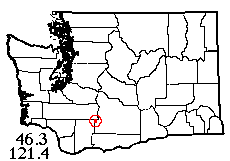 |
30 VII 1988: A butterfly-spider trip to the Baby Shoe Pass-Potato Hill area north of Mt. Adams on July 30 with Scarabs Kirk, Lucian, Pelham, and Crawford netted a good array of butterflies, including five new records for Skamania County: Polites sonora sonora, Euchloe ausonides, Phycioides campestris, Euphydryas editha colonia, and Erebia epipsodea hopfingeri. The habitat was open young forest of subalpine fir, Pacific silver fir, and mountain hemlock with small rocky clearings. Spiders were rather sparse (16 species including one rare jumping spider), but the strawberries were delicious!
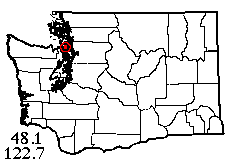 |
3 XII 1988: One of the handful of western Washington sites where black widow spiders have been found is on the west coast of Whidbey Island. Pratt and Hatch (1938, J. New York Entomol. Soc. 46: 191-3) described the habitat thus: "along the shoreline for a distance of about two miles on the western side of the island opposite the village of Coupeville. Here the land rises from the beach to a height of about 250 feet in a steep, grassy slope, which is well-drained and exposed to the sun. The spiders occur at the base of and on the surface of this slope under pieces of logs or bark." I have made two trips to this area, in part to determine if there were still black widows there. On June 16, 1987 I tried the area around Fort Ebey, and on December 3, 1988 I walked up the shoreline for one mile north of Ebeys Landing and crawled around on the very steep grassy slope at imminent peril of limb, if not life. A total of 9 spider species were recovered from the habitat described by Pratt and Hatch, none of them characteristic of arid environments. I not only found no black widows, but no old black widow webs or egg sacs. This raises several interesting questions: Are they still there somewhere, or is the population decimated or extinct? If the latter, what did them in - pesticides? moistening climate? And what would the public response be to pleas for conservation of an endangered black widow population?
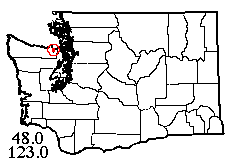 |
![]() 3 IV 1989: Another field trip of yr editor's was on April 3, when I checked
out the Sequim area with my friend Joyce. This trip was the first of a projected
series investigating undersampled "unique habitats." The original
area of Sequim Prairie is essentially all altered; for example, Carrie Blake
Park which was in the middle of one prairie belt is now a parking lot and lawns.
South of the park was a lawn-like pasture, but to the north was a reasonably
prairie-like habitat with long grass (including non-native species), thatching
ants (see album), and some prairie spiders. There
were no oaks in this tract, but some surrounding hillsides still have some good
though small stands of oak savanna. One other section of Sequim Prairie was
described as the best remnant in a 1975 natural landmarks report; we found few
of the old oaks remaining there, with more housing, a sawmill, and a trailer
park. Remaining grassland there was essentially "vacant lot" habitat.
3 IV 1989: Another field trip of yr editor's was on April 3, when I checked
out the Sequim area with my friend Joyce. This trip was the first of a projected
series investigating undersampled "unique habitats." The original
area of Sequim Prairie is essentially all altered; for example, Carrie Blake
Park which was in the middle of one prairie belt is now a parking lot and lawns.
South of the park was a lawn-like pasture, but to the north was a reasonably
prairie-like habitat with long grass (including non-native species), thatching
ants (see album), and some prairie spiders. There
were no oaks in this tract, but some surrounding hillsides still have some good
though small stands of oak savanna. One other section of Sequim Prairie was
described as the best remnant in a 1975 natural landmarks report; we found few
of the old oaks remaining there, with more housing, a sawmill, and a trailer
park. Remaining grassland there was essentially "vacant lot" habitat.
The bluff above
Dungeness Spit is an interesting habitat, and adjacent are some nice riparian
meadows which are now part of a county park. Gibson Spit at the head of Sequim
Bay (not officially a park, but seems to be public land) has the nicest habitats
we found in the area, including sandy beach, seaside meadow, and tidal marsh.
This area is noted for its low rainfall, and hasn't been checked out too well
entomologically.
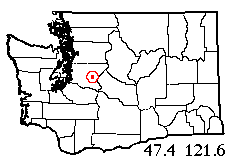 |
9 IV 1989: Oddly enough, no one called Scarab Foster about the official Scarabs trip even though the weather wasn't bad on the day we went (April 9). Apparently those who claim they want to go on field trips need a little more than an announcement to spur them to action. Anyway, the season for butterflies proved still extremely early in the Ellensburg area, with little out but overwintering species. On the way back, we revisited a cold spring just east of Twin Falls State Park where coleopterist Bob Nelson once extracted three unique new spider species from the wet moss. Those weren't rediscovered, but other very interesting spiders were found, so the trip wasn't wasted. This same weekend, Scarabs Pelham and Crabo went to the Wawawai area near Pullman, where they found a potentially very interesting habitat in riparian hawthorn woodland.
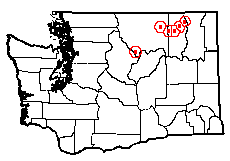 |
14-21 VI 1989: Yr editor just returned from a week's expedition to northeast Washington, Okanogan and Ferry Counties, with the museum's bird and mammal folks. The trip was productive, but frustrating due to frequent changes in plans. Because the Colville Indian Tribes delayed granting us collecting permission until after the scheduled time of the trip, we had to spend the first night "perched" on the fringe of the area. At our second campsite, in the northeastern Kettle Range, we were rained out and collecting was mediocre, so we moved again, to a beautiful meadow on Rabbit Creek southwest of Republic. We were just hitting our stride there when we were ousted by a bear scare! Moving camp again, to a decidedly less attractive spot across the valley, where the log trucks started rolling at 2:30 AM, we struggled on valiantly (fortunately, I managed to return to the Rabbit Creek area, in a spot aptly named Refrigerator Canyon, for a day trip). The second night in our last camp, my ride home happened to wake up in the middle of the night and decided to leave then rather than in the morning. I incredulously looked at my watch: 1:10 AM! We had to wait some time near Coulee City for the gas stations to open. When I got back, I was too zonked to type. And that, dear readers, is why this newsletter is late.
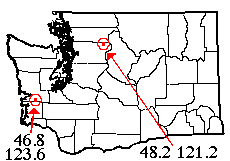 |
29 VII, 5 VIII 1989: Yr editor has had two recent field trips, one delightful, the other agonizing. On July 23, I went to the North River area (NW Willapa Hills) with three charming ladies: Helen Moser, daughter Kerstin, and friend Elizabeth. We had a lovely time in the seral forest, clearings and beaver meadows of Tuttle Creek and Scar Hill, despite winding up in a traffic jam on the way home. Helen made the "find" of the day: Habronattus ophrys, a very colorful jumping spider previously recorded from Corvallis south to California. On August 5, Scarab Edwards talked me into doing a murderous climb to Lime Ridge in Glacier Peak Wilderness for our long-planned grylloblattid hunt. I could barely move enough to collect a few spiders from the mountain hemlock and heather at Box Mountain Lake while John and Johnny (Palka) unsuccessfully sought grylloblattids near the talus. Then (groan) the hike down! A few days after our return, I was able to walk again.
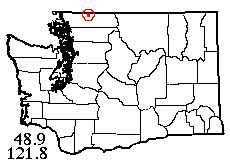 |
2 IX 1989: On the day of the Native Plant Society/Scarabs joint field trip, the Petersons (Jane & family), yr editor, Bob Kirk with Miriam, A.B. Adams, and a couple of other Native Planters showed up under an overcast sky and somewhat misty atmosphere at the Church Mountain trailhead. Among the plant folks was a pleasant surprise: Warren Jones, a former student of mine, who did for me (in 1977) one of the most interesting class projects ever, on the spider fauna of water meter boxes. Anyway, the others all trucked up the trail (2500-foot elevation gain to alpine meadows, groan!) while I collected spiders at the trailhead. I didn't really expect much, and was just trying to supplement a previous collection, but amazingly came up with 21 species and 2 spiders (one of them a very attractive Misumenops crab spider) new to Washington. In mid-afternoon, it began to rain; the sodden lepidopterists finally re-appeared, having seen one butterfly, a Lycaeides idas scared up from under a leaf.
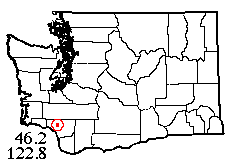 |
27-29 X 1989: On the same weekend as the Lepidopterists' Workshop in Oregon, yr editor had a moderately miserable collecting trip (setting up camp in the rain, to be greeted in the morning by a penetrating chill mist) at Seaquest State Park on the shore of marshy Silver Lake in Cowlitz County. My goal was achieved in spite of the weather; the Silver Lake marsh proved to be a fine habitat. When the ground is as soggy as it was this weekend, it helps to bring leaf litter back to the picnic table to sift. Among interesting finds was a male of the tiny blue-green Usofila pacifica. What made this so remarkable was that I previously had over 300 females of this species, and had about decided that males did not exist! Wanting some county records of house spider species, I asked permission to collect in the untenanted cabins of a local resort, and was refused - until the owner's cat came up and made friends with me, and he decided I must be OK!
This page last updated 21 March, 2025